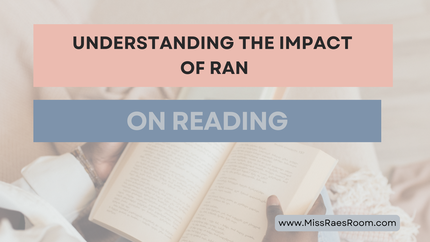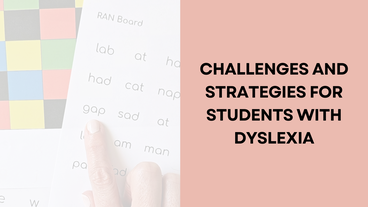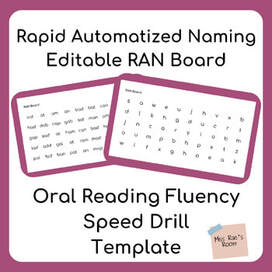|
6/22/2023 1 Comment Rapid Automatized Naming (RAN): Understanding Its Impact on Reading and Strategies for ImprovementDiscover the impact of Rapid Automatized Naming (RAN) on reading skills and effective strategies to improve student's RAN skills. Explore the importance of fluency and learn how to redefine fluency instruction for students with dyslexia. Implement proven approaches, such as structured literacy, phonics instruction, explicit fluency techniques, and memory strategies, to enhance overall reading fluency. Unlock the potential of students with dyslexia and empower them on their reading journey. Rapid automatized naming (RAN) is a task that measures how quickly students can name aloud objects, pictures, colors, or symbols (letters or digits). It has been identified as a strong predictor of a student's fluency and later reading ability, especially when it comes to letters and digits. Poor RAN scores are often associated with reading difficulties in students. In this article, we will define RAN, explore the impact of RAN on reading skills, and learn strategies to improve student's RAN skills. What is RAN?
Assessing RAN
RAN screeners like THESE can be used to informally assess a student’s RAN. By utilizing these assessments, educators and professionals can gain valuable insights into a student's Processing Speed abilities, identify areas of strengths and weaknesses, and make informed decisions regarding appropriate interventions and accommodations. Understanding the Impact of RAN on Reading:Slower-than-average RAN scores are often linked to struggles with word-level reading. Word-level reading requires readers to attend to individual words in a text, which is based on phonological and phonemic skills. Difficulties in accessing phonemes in spoken words can negatively affect reading development, including phonics, sight word acquisition, and fluency. Skilled word-level reading is a crucial gateway to achieving overall fluency, and research has shown that a student's vocabulary size significantly influences their fluency. Challenges and Strategies for Students with Dyslexia:
Strategies for Improving RAN Skills:So how can we teach RAN to improve students' reading? Research says we can’t. Well, kind of. Let me explain… While research suggests that RAN training alone may not directly improve reading skills, there are strategies that can enhance overall fluency and integrate reading skills for students with dyslexia. The Structured Literacy approach to reading is considered to be the best methodology for improving students’ oral reading fluency. Implement a systematic and explicit approach that focuses on teaching the structure of language, including phonology, morphology, and syntax. This approach provides structured instruction in phonemic awareness, phonics, and decoding skills to develop a strong foundation for reading. At the word-level, readers must attend to the individual word in a text. Word-Level reading skills are based upon phonological/phonemic skills. Poor access to phonemes in spoken words negatively affects reading development. Such difficulties affect phonic development, sight word acquisition, and fluency. So our intervention instruction should target automaticity of advanced phonemic awareness skills, explicit instruction in lagging phonics skills, direct fluency instruction, and include RAN charts, word part and word drills, memory strategies, and games! Intervention Instruction Components:
Password, Scattergories, Taboo, Pictionary, Boggle, Crosswords, and Charades can engage students and provide opportunities for quick thinking and retrieval of information. By combining these strategies and approaches, teachers can provide targeted instruction to improve fluency skills while integrating reading skills effectively. While RAN training alone may not directly improve reading skills, it is possible to enhance overall fluency for students with dyslexia by implementing specific instructional strategies. By prioritizing the development of a sight vocabulary, comprising both phonetically regular and irregular words, students can improve their instant recognition and reading of familiar words. Remember that fluency should be defined based on individual student needs, focusing on achieving a moderate rate and expression when reading. By understanding the impact of RAN on reading and employing effective strategies, we can support students in becoming confident and proficient readers. Happy & Healthy Teaching! Miss Rae Related Resources...Related Blogs...
1 Comment
Susan
7/4/2023 08:40:54 am
I would LOVE to learn more about this!
Reply
Your comment will be posted after it is approved.
Leave a Reply. |
CategoriesAll Comprehension CoPlanning CoTeaching Directed Reading DIY Fluency Fountas & Pinnell Graphic Organizers Guided Reading Lesson Planning Multi-Tiered Systems Of Support Phonological Awareness RAN Read And Respond Reading Reading Assessments Reading Comprehension Response To Intervention RTI Science Of Reading Science Of Reading For Special Education Teachers Special Education Special Education Eligibility Special Education Lesson Planning Teaching Strategy Visualizing & Verbalizing Visual Texts Vocabulary Writing Writing In Response To Reading |











 RSS Feed
RSS Feed